How to identify scams like the fake "MetaMask Wallet Verification" notification
Phishing/ScamAlso Known As: MetaMask Wallet Verification phishing email
Get free scan and check if your device is infected.
Remove it nowTo use full-featured product, you have to purchase a license for Combo Cleaner. Seven days free trial available. Combo Cleaner is owned and operated by RCS LT, the parent company of PCRisk.com.
What is "MetaMask Wallet Verification"?
Our analysis of the email has revealed that it is a fraudulent letter masquerading as a notification from MetaMask regarding wallet verification. The scammers behind this phishing scheme aim to lure unsuspecting recipients into disclosing personal information on a fake web page. Recipients should ignore such emails to avoid potential consequences.
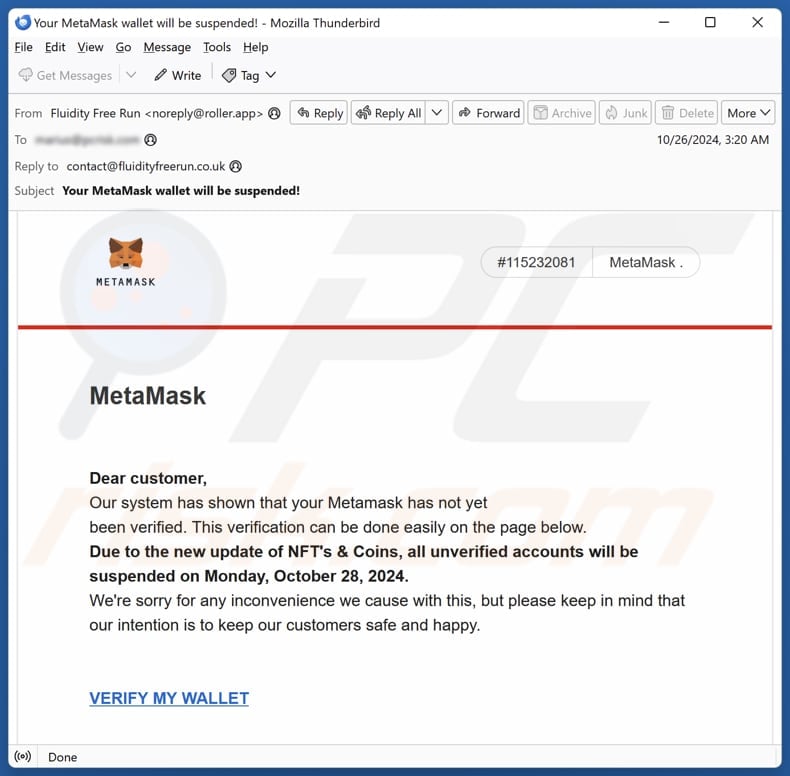
More about the "MetaMask Wallet Verification" scam email
The phishing email claims to be from MetaMask and warns the recipient that their wallet has not been verified. It states that unverified accounts will be suspended by the specified date due to a new update regarding NFTs and coins. The email urges the recipient to verify their wallet through a provided link ("VERIFY MY WALLET" button).
Clicking the link included in this scam email opens a fake MetaMask website instructing users to unlock (recover) their wallets by entering their recovery phrase. If users enter their recovery phrase on this website, scammers can gain access to their cryptocurrency wallets and steal cryptocurrency holdings.
Additionally, having the recovery phrase may enable scammers to change the wallet's password or other security features, making it even harder for the victim to regain control. Ultimately, falling for scams like this can lead to significant financial losses for the victim.
| Name | MetaMask Wallet Verification Email Scam |
| Threat Type | Phishing, Scam, Social Engineering, Fraud |
| Fake Claim | Recipient's MetaMask account has not yet been verified |
| Related Domains | quintapata.com[.]ar, leadme.com[.]ar |
| Detection Names (quintapata.com[.]ar) | alphaMountain.ai (Phishing), Combo Cleaner (Phishing), Criminal IP (Phishing), Lionic (Malware), SOCRadar (Malware), Full List Of Detections (VirusTotal) |
| Detection Names (leadme.com[.]ar) | alphaMountain.ai (Phishing), Cluster25 (Phishing), CRDF (Malicious), CyRadar (Phishing), Fortinet (Phishing), Full List Of Detections (VirusTotal) |
| Disguise | Letter from MetaMask |
| Symptoms | Unauthorized online purchases, changed online account passwords, identity theft, illegal access of the computer. |
| Distribution methods | Deceptive emails, rogue online pop-up ads, search engine poisoning techniques, misspelled domains. |
| Damage | Loss of sensitive private information, monetary loss, identity theft. |
| Malware Removal (Windows) |
To eliminate possible malware infections, scan your computer with legitimate antivirus software. Our security researchers recommend using Combo Cleaner. Download Combo CleanerTo use full-featured product, you have to purchase a license for Combo Cleaner. 7 days free trial available. Combo Cleaner is owned and operated by RCS LT, the parent company of PCRisk.com. |
Similar scam emails in general
Phishing emails are designed to trick recipients into revealing sensitive information, such as passwords, credit card details, ID card information, etc. They often appear as letters from legitimate companies or other entities and encourage recipients to act quickly. These emails typically contain suspicious links or attachments.
Some examples of phishing emails are "Security Token For Business Email Is Outdated", "Mailbox Security Maintenance", and "Payment Details". Users should be aware that emails of this kind can be used to distribute malicious software.
How do spam campaigns infect computers?
Threat actors often utilize email to spread malware by deceiving users into opening harmful files or links. These emails can include various files, such as executable files, Microsoft Office documents, PDFs, ISO files, scripts, and compressed files like ZIP or RAR. Opening any of these files can trigger the execution of malware.
For instance, malicious Microsoft Office documents typically require users to enable macros for the malware to execute, while opening malicious executable files can result in immediate malware deployment. Links within these emails may direct users to websites designed to prompt malware downloads or may initiate malicious downloads automatically.
How to avoid installation of malware?
Scrutinize emails thoroughly before opening attachments or clicking links. Do not open links or files in emails from unfamiliar senders and (or) if emails seem irrelevant, unexpected. Avoid clicking advertisements, pop-ups, buttons, or links on dubious websites. Keep your operating system and applications up to date.
Download software and files exclusively from trustworthy sources, such as official websites and app stores, and avoid pirated software or cracking tools. Conduct regular system scans using a reputable security tool. If you have already opened malicious attachments, we recommend running a scan with Combo Cleaner Antivirus for Windows to automatically eliminate infiltrated malware.
The appearance of the "MetaMask Wallet Verification" email (GIF):
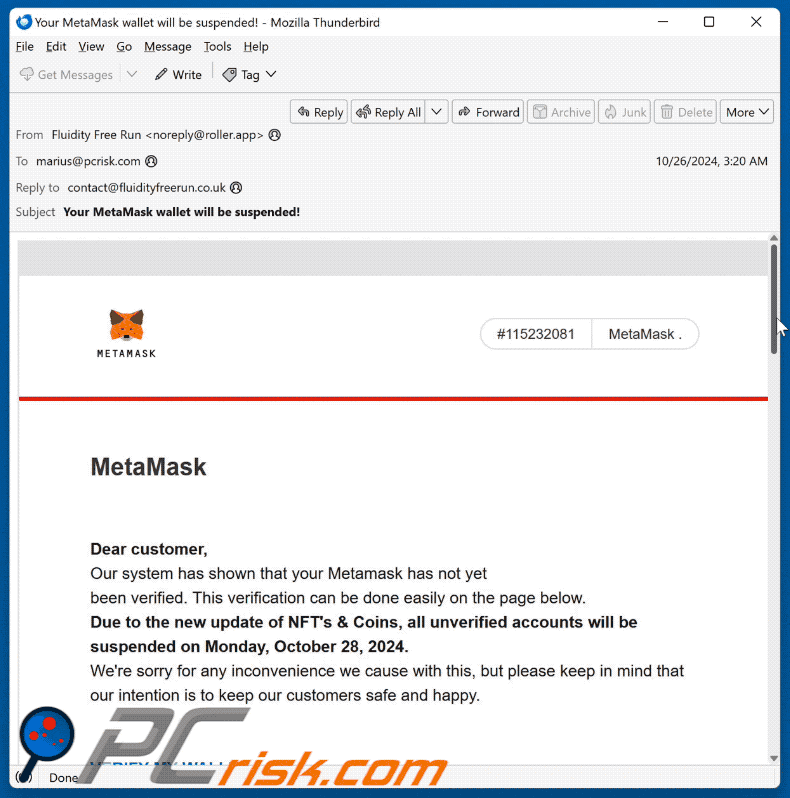
Text presented in the "MetaMask Wallet Verification" email letter:
Subject: Your MetaMask wallet will be suspended!
#115232081 MetaMask .
MetaMaskDear customer,
Our system has shown that your Metamask has not yet
been verified. This verification can be done easily on the page below.
Due to the new update of NFT's & Coins, all unverified accounts will be suspended on Monday, October 28, 2024.
We're sorry for any inconvenience we cause with this, but please keep in mind that our intention is to keep our customers safe and happy.VERIFY MY WALLET
Phishing website used in this scam:
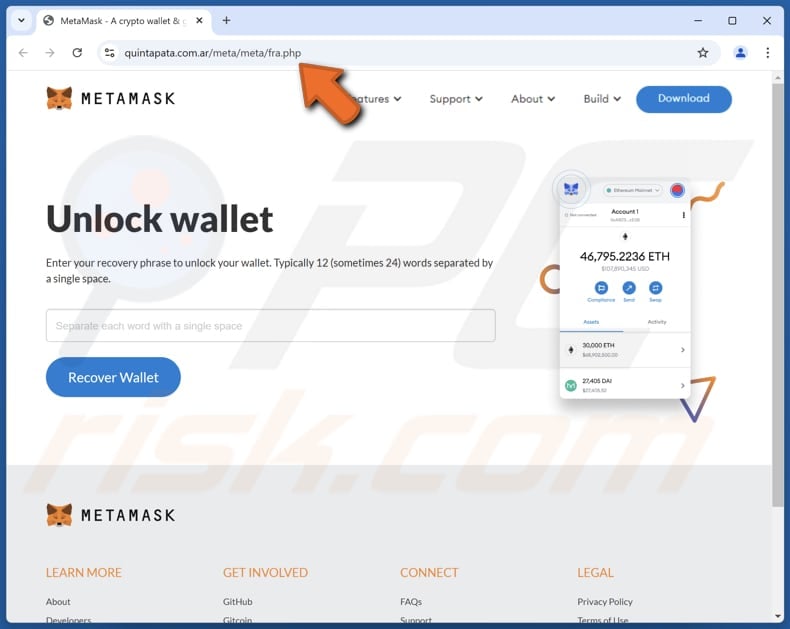
Another example of MetaMask wallet verification-themed spam email promoting a phishing site:
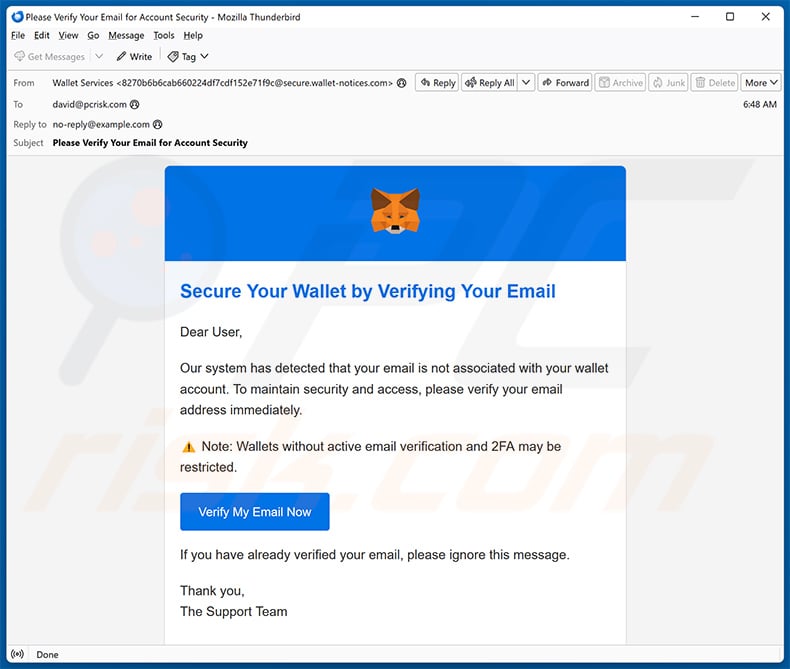
Text presented within:
Subject: Please Verify Your Email for Account Security
Secure Your Wallet by Verifying Your Email
Dear User,
Our system has detected that your email is not associated with your wallet account. To maintain security and access, please verify your email address immediately.
Note: Wallets without active email verification and 2FA may be restricted.
Verify My Email NowIf you have already verified your email, please ignore this message.
Thank you,
The Support TeamThis is an automated message. Please do not reply.
© 2025. All rights reserved.
Screenshot of the promoted phishing site:
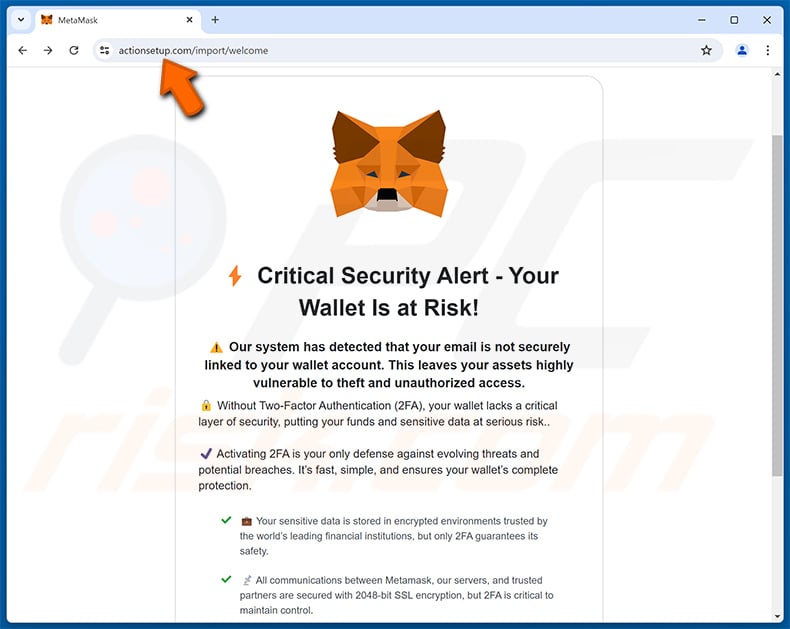
Instant automatic malware removal:
Manual threat removal might be a lengthy and complicated process that requires advanced IT skills. Combo Cleaner is a professional automatic malware removal tool that is recommended to get rid of malware. Download it by clicking the button below:
DOWNLOAD Combo CleanerBy downloading any software listed on this website you agree to our Privacy Policy and Terms of Use. To use full-featured product, you have to purchase a license for Combo Cleaner. 7 days free trial available. Combo Cleaner is owned and operated by RCS LT, the parent company of PCRisk.com.
Quick menu:
- What is MetaMask Wallet Verification phishing email?
- Types of malicious emails.
- How to spot a malicious email?
- What to do if you fell for an email scam?
Types of malicious emails:
![]() Phishing Emails
Phishing Emails
Most commonly, cybercriminals use deceptive emails to trick Internet users into giving away their sensitive private information, for example, login information for various online services, email accounts, or online banking information.
Such attacks are called phishing. In a phishing attack, cybercriminals usually send an email message with some popular service logo (for example, Microsoft, DHL, Amazon, Netflix), create urgency (wrong shipping address, expired password, etc.), and place a link which they hope their potential victims will click on.
After clicking the link presented in such email message, victims are redirected to a fake website that looks identical or extremely similar to the original one. Victims are then asked to enter their password, credit card details, or some other information that gets stolen by cybercriminals.
![]() Emails with Malicious Attachments
Emails with Malicious Attachments
Another popular attack vector is email spam with malicious attachments that infect users' computers with malware. Malicious attachments usually carry trojans that are capable of stealing passwords, banking information, and other sensitive information.
In such attacks, cybercriminals' main goal is to trick their potential victims into opening an infected email attachment. To achieve this goal, email messages usually talk about recently received invoices, faxes, or voice messages.
If a potential victim falls for the lure and opens the attachment, their computers get infected, and cybercriminals can collect a lot of sensitive information.
While it's a more complicated method to steal personal information (spam filters and antivirus programs usually detect such attempts), if successful, cybercriminals can get a much wider array of data and can collect information for a long period of time.
![]() Sextortion Emails
Sextortion Emails
This is a type of phishing. In this case, users receive an email claiming that a cybercriminal could access the webcam of the potential victim and has a video recording of one's masturbation.
To get rid of the video, victims are asked to pay a ransom (usually using Bitcoin or another cryptocurrency). Nevertheless, all of these claims are false - users who receive such emails should ignore and delete them.
How to spot a malicious email?
While cyber criminals try to make their lure emails look trustworthy, here are some things that you should look for when trying to spot a phishing email:
- Check the sender's ("from") email address: Hover your mouse over the "from" address and check if it's legitimate. For example, if you received an email from Microsoft, be sure to check if the email address is @microsoft.com and not something suspicious like @m1crosoft.com, @microsfot.com, @account-security-noreply.com, etc.
- Check for generic greetings: If the greeting in the email is "Dear user", "Dear @youremail.com", "Dear valued customer", this should raise suspiciousness. Most commonly, companies call you by your name. Lack of this information could signal a phishing attempt.
- Check the links in the email: Hover your mouse over the link presented in the email, if the link that appears seems suspicious, don't click it. For example, if you received an email from Microsoft and the link in the email shows that it will go to firebasestorage.googleapis.com/v0... you shouldn't trust it. It's best not to click any links in the emails but to visit the company website that sent you the email in the first place.
- Don't blindly trust email attachments: Most commonly, legitimate companies will ask you to log in to their website and to view any documents there; if you received an email with an attachment, it's a good idea to scan it with an antivirus application. Infected email attachments are a common attack vector used by cybercriminals.
To minimise the risk of opening phishing and malicious emails we recommend using Combo Cleaner Antivirus for Windows.
Example of a spam email:

What to do if you fell for an email scam?
- If you clicked on a link in a phishing email and entered your password - be sure to change your password as soon as possible. Usually, cybercriminals collect stolen credentials and then sell them to other groups that use them for malicious purposes. If you change your password in a timely manner, there's a chance that criminals won't have enough time to do any damage.
- If you entered your credit card information - contact your bank as soon as possible and explain the situation. There's a good chance that you will need to cancel your compromised credit card and get a new one.
- If you see any signs of identity theft - you should immediately contact the Federal Trade Commission. This institution will collect information about your situation and create a personal recovery plan.
- If you opened a malicious attachment - your computer is probably infected, you should scan it with a reputable antivirus application. For this purpose, we recommend using Combo Cleaner Antivirus for Windows.
- Help other Internet users - report phishing emails to Anti-Phishing Working Group, FBI’s Internet Crime Complaint Center, National Fraud Information Center and U.S. Department of Justice.
Frequently Asked Questions (FAQ)
Why did I receive this email?
This email was likely sent to many recipients, suggesting that you were not individually targeted by the scammers.
I have provided my personal information when tricked by this email, what should I do?
If you have provided login credentials, change the compromised passwords (and seed phrases) to prevent scammers from accessing your accounts. If some accounts cannot be accessed, contact their support.
I have downloaded and opened a file attached to this email, is my computer infected?
The likelihood of infection varies by file type. For instance, if you opened a compromised Word document without enabling macros, you may have prevented the malware from activating. However, opening an infected executable file typically results in system compromise.
I have read the email but did not open the attachment, is my computer infected?
Emails cannot infect computers, so opening them is safe. However, opening malicious attachments or links in fraudulent emails can result in computer infections.
Will Combo Cleaner remove malware infections that were present in email attachment?
Yes, Combo Cleaner can identify and remove nearly all known malware infections. However, advanced malware often conceals itself deep within the system, so it is important to perform a full system scan to ensure successful removal.
Share:

Tomas Meskauskas
Expert security researcher, professional malware analyst
I am passionate about computer security and technology. I have an experience of over 10 years working in various companies related to computer technical issue solving and Internet security. I have been working as an author and editor for pcrisk.com since 2010. Follow me on Twitter and LinkedIn to stay informed about the latest online security threats.
PCrisk security portal is brought by a company RCS LT.
Joined forces of security researchers help educate computer users about the latest online security threats. More information about the company RCS LT.
Our malware removal guides are free. However, if you want to support us you can send us a donation.
DonatePCrisk security portal is brought by a company RCS LT.
Joined forces of security researchers help educate computer users about the latest online security threats. More information about the company RCS LT.
Our malware removal guides are free. However, if you want to support us you can send us a donation.
Donate
▼ Show Discussion